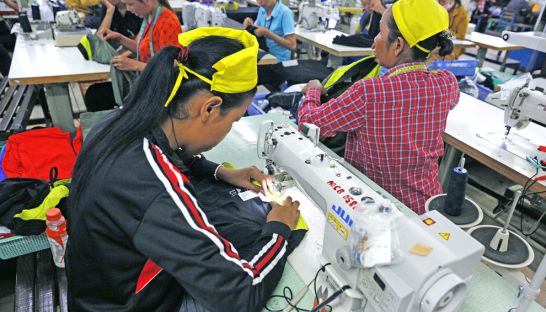ANZ backs manufacturing to move up the value chain
ANZ backs manufacturing to move up the value chain
As Mekong Basin economies increasingly move into to higher-skilled production, Cambodia also looks set to step up the value chain as long as its government sustains the effort, according to ANZ’s latest Mekong Quarterly Outlook.

The report said that Asian countries have traditionally “cascaded up” value chains, with poorer nations in the region attracting low-skilled industries such as garments which have been driven out by higher wages in other countries.
While Cambodia’s economy has benefited from the migration of garment factories from places like Thailand, the Kingdom’s comparative advantage of cheap labour has not changed much over the past decade, according to the report.
“Cambodia’s industrial sector lacks diversity, with a narrow focus on garments and food processing where the level of sophistication adopted is still low. Most manufacturing activities are still family-based and lack the capacity to compete in the international market,” the report read.
Of the five countries included in an ANZ metric – Cambodia, Laos, Myanmar, Vietnam, and Thailand – Cambodia had the highest comparative advantage when it comes to low-margin, labour-intensive sectors like garments and footwear production.
Cambodia also had the highest percentage – more than 80 per cent – of its exports coming from products which are “labour and resource intensive”, compared to less than half for Vietnam.
However, ANZ said it expected Cambodia to evolve thanks to government support, citing historic examples of state-led economic development like in South Korea and Japan.
“Nonetheless, we expect these dynamics to change with the structural transformation of the domestic economy due to the government’s industrial development reforms.”
Cambodia’s Rectangular Strategy expects the Kingdom to become a higher middle income country by 2030, while the ten-year Industrial Development Policy announced in March of this year seeks to diversify the economy towards sectors such as light manufacturing and agribusiness.
Mey Kalyan, senior adviser to the Supreme Economic Council, said that the Cambodian government was committed to industrialisation, although implementation of the plan remained a key issue.
“Cambodia still has a problem with implementation,” he said.
“We start late [compared to neighbouring countries], but we have strong commitment.”
Kalyan said he doubted that heavy state intervention would be enacted to spur the economy as has been done in other Asian countries in the past.
Instead, the Kingdom needs to improve its citizens’ skills to attract foreign investment into its relatively open market.
“We have so many people but our people are not fit enough for high-value added production,” he said.
“If we have good people, FDI [foreign direct investment] will come.”
ANZ says that multilateral agreements such as the impending ASEAN Economic Community would quicken the pace of development.
Nevertheless, independent economist Chan Sophal said Cambodia still faced numerous challenges on the path to prosperity.
“It’s difficult to say [if Cambodia can achieve its industrial development reforms] given the lack of many favourable conditions, such as infrastructure, affordable energy, and institutional capacity,” he said.
Sophal added that the situation was improving, with investments in hydropower and infrastructure set to attract more foreign investors in the long run.













